by Nina
So far, in Part 1 we learned about how English and Sanskrit are related, so some of those mysterious words you’ve been hearing will actually easy to remember if you connect them with the corresponding English words (for example, supta for supine and kona for corner/angle). Then in Part 2 we learned some of the Sanskirt words for different body parts that commonly appear in pose names (for example, pada for foot and mukha for face).
Today we’re going to look at modifiers that frequently appear either at the end or beginning pose names. We’ll start with the ones at the end because there are only two (that I could think of, anyway) and they’re both very important. Then we’ll look at the ones that come at the beginning.
Ending Modifiers
Asana/Pose or Seat: This originally meant “seat” because all the most ancient poses (or maybe all?) were seated poses for meditation. However, eventually it came to mean “pose” as in any yoga pose or, as we often still say, asana. And you probably have noticed by now that almost every Sanskrit pose name ends with “asana.” Some pose names we have already translated include:
- Paschimottanasana
- Trikonasana
- Utthita Parsvakonasana
- Padanguthasana
- Gomukasana
But most of the ones we haven’t translated because they are based on animal or plant names or the names of a yoga sage also include “asana.”
- Vrksasana = Tree pose
- Salabasana = Locust pose
- Padmasana = Lotus pose
- Marichyasana = Marichi’s pose
- Hanumanasana = Hanuman’s pose
So one way to make a pose name easier to understand is just to translate the asana part first.
There are a few exceptions of poses that don’t include the word “asana,” such as Viparita Karani, which means Inverted Lake. (I do not have an explanation for why that is.)
Uttana/Intense Stretch: When “uttana” is combined with “asana” there is a contraction so instead of two a’s, there is just one. The most obvious case of this is in the pose name “Uttanasana,” which means “Intense Stretch Pose.”
But then you’re going to see the whole word “uttanasana” added on to a whole lot of other pose names, where there is another contraction and the “u” is removed.
- Paschimottanasana = Back Body Intense Stretch Pose
- Parsvottanasana = Side Body Intense Stretch Pose
- Purvottanasana = Front Body Intense Stretch Pose
- Prasarita Paddottanasa = Widespread Legs Intense Stretch Pose
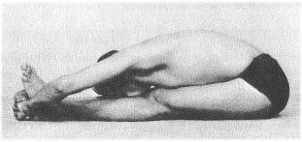 |
| Paschimottanasana |
Beginning Modifiers
Now we’re going to go through the words that often appear at the beginning of pose names. Some will sound familiar to you from previous lessons but we’ll go through those again so you can see how they relate to other terms and to help them sink in.
Supta/Supine: This is used for poses that are the reclined version of another pose. Examples:
- Supta Baddha Konasana = Supine Bound Angle Pose
- Supta Padangusthasana = Supine Big Toe Pose
- Supta Virasana = Supine Hero Pose
- Supta Konasana = Supine Angle Pose
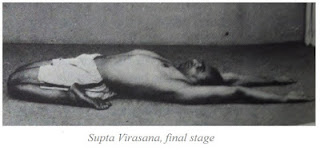
Paripurna/Full: For some poses there are both “full” and “half” versions. So this modifier tells you which of the two the pose is. Examples:
- Paripurna Navasana = Full Boat Pose
- Paripurna Matsyendrasana = Full Matsyendra’s pose (yes, it exists, I did it a few times back in the day)
- Paripurna Ustrasana = Full Camel Pose. Haha, you thought you were doing full Camel pose already? Nah, that’s Half Camel pose. In Full Camel pose, your head is all the way down and touching your feet, while your hands are on your knees (it’s a lot like Pigeon Pose).
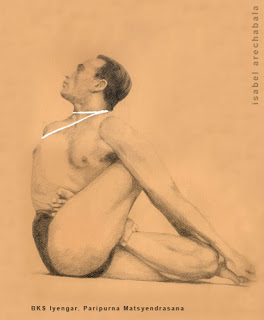 |
Arda/Half: We see this more often than full because sometimes the full pose doesn’t have that modifier, but the “half” version does. Or, as in the case of Arda Chandrasana, maybe there is no full version. Examples:
- Arda Navasana = Half Boat Pose
- Ardha Chandrasana = Half Moon Pose
- Ardha Adho Mukha Svanasana = Half Downward-Facing Dog Pose
- Arda Halasana pose = Half Plow Pose
- Arda Padmasana = Half Lotus Pose
- Arda Matsyendrasana = Half Matsyendra’s Pose
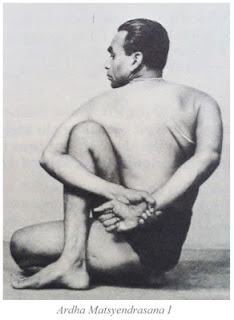
Salamba/Supported: This means using your hands to support your body, rather than using a prop. So a propped version of a pose is NOT salamba. Examples:
- Salamba Sarvangasana = Supported Shoulderstand Pose. This is the way most of us practice the pose, with our hands supporting our backs.
- Salamba Sirsasana = Supported Headstand Pose. This is the way most of us practice the pose, with forearms on the ground or just hands (Tripod Headstand).
- Salamba Bhujangasa = Sphinx Pose. You are supporting Cobra pose by putting your forearms on the ground.
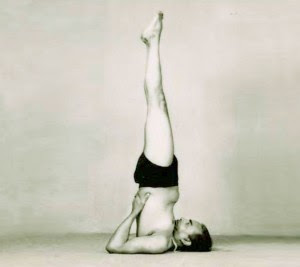 |
| Salamba Sarvangasana |
Nirlamba/Usupported: This is the version of the pose with no hands!
- Nirlamba Parsvakonasana = Unsupported Side Angle Pose. This is the version of the pose where you clasp your hands behind your back rather than putting one hand on the ground (or block).
- Nirlamba Sarvangasana = Unsupported Shoulderstand Pose. In this version you either have your hands on the ground over head or on the fronts of your legs.
- Nirlamba Sirsasana = Unsupported Headstand Pose. In this version you balance on your head only with your arms along the sides of your body.
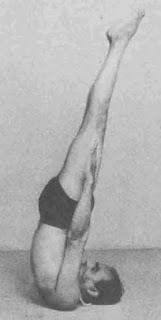
Eka/One: This is usually used with “pada” for a one-footed or one-legged version of a pose or with “hasta” for one hand.
- Eka Pada Bakasana = One Legged Crane Pose
- Eka Pada Rajakapotasana = One Legged King Pigeon Pose
- Urdhva Prasarita Eka Padasana = Upward Widespread One Foot Pose aka Standing Splits
- Eka Hasta Bujasana = One Hand Arms pose aka Elephant Trunk pose (a common arm balance)
- Urdhva Prasarita Eka Padasana = Upward Widespread One Foot Pose aka Standing Splits
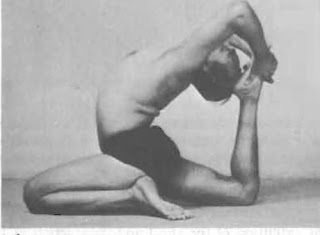 |
| Eka Pada Rajakapotasana |
Dwi/Two: This is usually used with “pada” for a two-footed or two-legged version of a pose or with “hasta” for two hands. Examples:
- Dwi Hasta Bhujasana = Two Hands Arm pose aka Two Legs Over Arms pose (a common arm balance)
- Dwikonasana = Two Angle pose or Double Angle pose. This is the standing orward bend with clasped hands brought overhead—great shoulder opener!
- Dwi Pada Viparita Dandasana = Two Footed Inverted Staff pose
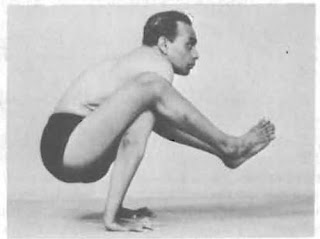 |
| Dwi Hasta Bhujasana |
Parivrtta/Turned Around or Revolved. We often see this one as the “twisting” version of a common pose.
- Parivrtta Parsvakonasana = Revolved Side Angle Pose
- Parivritta Trikonasana = Revolved Triangle Pose
- Parivritta Arda Chandrasana = Revolved Half Moon Pose
- Parivrtta Janu Sirsasana = Revolved Head to Knee Pose
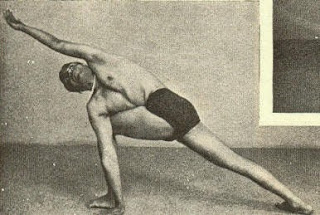 |
| Parivrtta Parsvakonasana |
Parsva/Sideways or Side of the Body: As opposed to a twist, this has to do with doing the pose to the side or stretching the side of the body.
- Parsva Upavista Konasana = Sideways Seated Angle Pose (Parivrtti Upavista Konasana is a different pose—it is a twist not a turn to the side)
- Pasva Bakasana = Sideways Crane Pose
- Parsva Sukasana = Side-bending Easy Sitting Pose
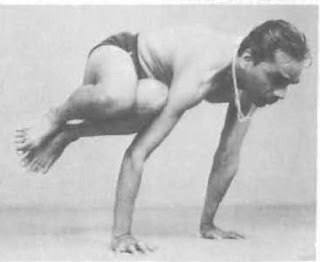 |
| Parsva Bakasana |
Utthita/Extended: Because this word doesn’t really add that much to a pose name, many teachers (guilty as charged) leave it off the Sanskrit name.
- Utthita Trikonasana = Extended Triangle Pose
- Utthita Parsvakonasana = Extended Side Angle Pose
- Utthita Hasta Padangusthasana = Extended Hand to Big Toe Pose
- Utthita Hasta Padasana = Extended Arms and Legs Pose. Hey, this is the name for the prep pose you do before moving into Triangle, Extended Side Angle, and so on. And in this case including utthita is pretty important for the name.
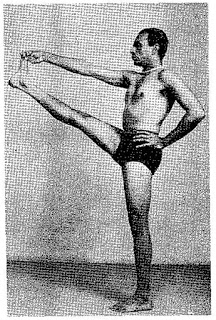 |
| Utthita Hasta Padangusthasana |
Prasarita/Expanded or Widespread. This usually means to body parts are spread away from each other.
- Prasarita Padottanasana = Widespread Legs Intense Stretch pose aka Wide-Legged Standing Forward Bend
- Urdhva Prasarita Eka Padasana = Upward Widespread One Foot Pose aka Standing Splits
- Urdhva Prasarita Padottanasana = Upward Extended Legs Intense Stretch Pose
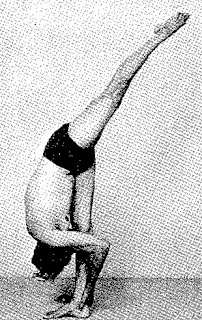 |
| Urdva Prasarita Eka Padasana |
Urdva/Up or Upward: We see this used alone as well as with mukha for face. Examples:
- Urdva Dhanurasana = Upward Bow Pose
- Urdhva Hastasana = Upward Hands Pose
- Urdva Mukha Svanasana = Upward-Facing Dog Pose
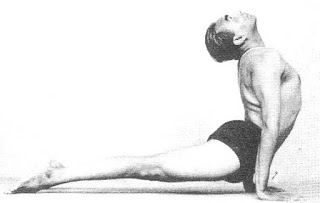 |
| Urdhva Mukha Svanasana |
Hey remember I talked about how knowing the Sanskrit helps eliminate confusion? I saw Urdhva Prasarita Padottanasana (on your back with legs up) translated four different ways:
- Upward Extended Feet Pose
- Raised Stretched-Out Foot Pose
- Upward Stretched Legs
- Upward Extended Legs
Adho/Down or Downward. So far, I’ve only seen this with “face.” Examples:
- Adho Mukha Svanasana = Downward-Facing Dog Pose
- Adho Mukha Virasana = Downward-Facing Hero Pose (with your arms along the floor)
- Adho Mukha Vrksasana = Downward-Facing Tree Pose aka Handstand
- Adho Mukha Dandasana = Downward-Facing Staff pose aka Plank Pose
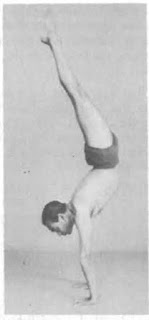 |
| Adho Mukha Vrksasana |
Wow, this turned out to be a long post! And you now have quite a long list of common Sanskrit words to remember. However, even if you remember only a few of them, I hope at least you will be less afraid of the language. Because, as I hope you’ve learned, the vocabulary in the pose names is actually very limited and the pose names are all very logical.
CHALLENGE: Translate this pose name into English and see if you can figure out which pose it is (I bet you’ve done it). See here for the answer and a photo.
Parivritta Prasarita Paddotanasana
Follow Yoga for Healthy Aging on Facebook ° To order Yoga for Healthy Aging: A Guide to Lifelong Well-Being, go to Amazon, Shambhala, Indie Bound or your local bookstore.


Leave A Comment